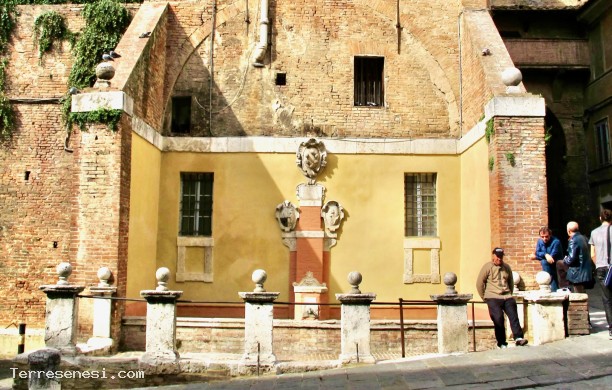> Home > What to visit > Fountains

Fonte di San Maurizio Siena
FOUNTAINS

PHONE NUMBERS AND TIMES
Fonte di San Maurizio
Ponte di Romana 53100 Siena
Business card (vCard)
On the left side of the Ponte di Romana, going down Via di San Girolamo to the right, we find the 14th-century Fountain of San Maurizio.
In this area of the city, lacking public fountains, drinking water was scarce, and the municipality supported and financed private citizens to dig wells or cisterns.
In 1293, it paid 18 lire to a blacksmith named Tura di Maffeo who had dug a cistern near the Porta di San Maurizio, which even won a prize for its remarkable size. For a long time, it was the only means of quenching the thirst of the local inhabitants and watering the horses.
Biccherna paid master worker Donato 41 lire, 14 soldi, and 4 denari for bricks, wood, and labor, while on November 14th and December 21st of the same year, it paid Gherio di Mino Compagni 100 and 200 lire for the construction of the drinking trough. In 1363, 131 lire and 10 soldi were spent on San Maurizio for its partial renovation; the workman for the fountain was Giovanni Bracci.
In 1376, Piero di Bartolo incurred further expenses for emptying and cleaning. At that time, the fountain did not have a special custodian, so the Municipality supervised its maintenance through its public officials.
When new water from the Staggia River began to feed the fountain in Piazza del Campo on June 19, 1461, the Republic decided to channel an overflow towards San Maurizio, but despite this, the water flow from the fountain remained low.
Because of its location on a slope, this fountain was renovated in 1474 with a stepped system. The main basin remained at the top, the drinking trough below, and the washhouse at the bottom. Even today, only the dividing walls that characterized this fountain in the past can be seen, as only the main basin remains intact of the original structure.
Inside, after recent cleaning and restoration, the Medici coat of arms can be admired at the top; on the left, a coat of arms with the black and white emblem of Siena and the lion of the people; and on the right, another coat of arms with a lion's paw, the coat of arms of Giulio del Caccia, governor of the city at the time of a major restoration. Below the coats of arms is a lion's head from which the water flows.
In the center of the basin, there is still a brick pedestal with a bronze spout beneath it. During the 16th-century restoration, a cherub astride a dolphin, from which water spouted, stood on this pedestal.
Despite being the only fountain in the Valdimontone district, its water is not used for baptisms. On the day before the Feast of the Titular Saint, the Prior receives children to be baptized in the amphitheater adjacent to the Hall of Victories, where the baptismal rite is performed.
STAY NEARBY
ALL'OMBRA DELLA TORRE
SIENA
...I TERZI
SIENA
I nostri appartamenti si trovano nel centro storico di Siena, a due passi da Piazza del C...LA CASA DEL GIGLIO
SIENA
...DINING & ENTERTAINMENT NEARBY
Teatro Comunale dei Rinnovati
SIENA
Located inside the Palazzo Comunale of Siena, the theater was built around 1560 by Bartolo...Teatro Dei Rozzi
SIENA
Non è da tutte le città avere due teatri bellissimi, perfettamente funzionan...Buca Di S. Pietro
SIENA
Dal 2003 il risorante è stato acquisito dalla famiglia Lorenzoni, sotto la guida de...


